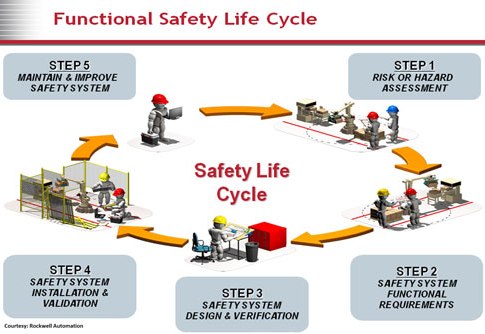Safety lifecycle approach is best when robots and humans work in the same areas, say automotive and safety experts from Rockwell Automation.

Harmonized international standards on industrial robotic safety allow humans and moving robots to occupy the same space. Because safety standards allow robots and humans to co-operate, robotic manufacturers have responded. How can this provide advantages? Automotive and safety experts from Rockwell Automation answer several key questions and offer recommendations.
Best-practice guidelines
Control Engineering (CE): What are best-practice guidelines for human-robot interactions?
Chris Brogli, business development manager, safety, Rockwell Automation: When humans and robots interact in a shared space at the same time, customers should use a safety lifecycle approach when designing machinery safety systems. The safety lifecycle approach, pictured below, is an industry best practice that helps to ensure proper safety system implementation. Several safety standards—ISO 12100, 13849, 62061, and 61508, and IEC 60204—outline the requirements for each step in the functional safety lifecycle.
The first step is an assessment, which helps identify the risks to determine the best technologies, measures, and practices to minimize those risks. Developing a functional specification outlines what the various robot-human interactions could be in the shared space and how the system will operate in each mode of operation. The selection, design, and verification step helps ensure that the design is in-line to meet the requirements defined in the initial risk assessment. Validation is another step that is used to ensure that the safety system operates as intended.
George Schuster, senior industry specialist, automotive team, Rockwell Automation: The safety lifecycle approach is the best way to eliminate hazards by design, especially when working side-by-side with robots.
OSHA’s response
CE: What will OSHA say as robots and humans work in the same space?
Schuster: There are two responses we can reasonably expect from OSHA. One is that OSHA as an organization may eventually make an official response regarding guidelines for robot-human interactions. Robot-human interaction can be a challenging area for OSHA to place guidelines around because as robot and safety automation technology continues to advance, it allows closer operator-interaction with moving equipment. Current OSHA specifications focus on the lockout/tagout approach. The second consideration is that OSHA responses will likely differ from one individual inspector to another based on his/her experience with robot-human interaction.
Brogli: Rockwell Automation has been working with OSHA to educate inspectors and customers alike on robot-human interaction and safety best practices. As OSHA becomes more experienced and knowledgeable with robotic equipment and safety functions, the more prevalent robot-human interaction will become in the industry.
Cooperation creates tireless adaptability
CE: What are the advantages of robot-human collaboration?
Schuster: One advantage of robots and humans cooperating is the tools and technologies we have now that we didn’t have before. The combination of robot features such as strength, repeatability, and tirelessness with human skills of intelligence and adaptability is a game-changer for how manufacturing processes can be designed to operate more productively and how people and machinery can work together more effectively. For example, ergonomic issues are reduced when robots can execute certain tasks like repeatedly lifting large or heavy objects. In turn, we have seen and will continue to see more technologies that allow manufacturers to produce more product faster while removing the physical burden from operators and improving overall process flexibility.
Brogli: Robot-human interaction improves productivity. It helps provide a smarter, safer system that is more flexible and can change from product to product through interaction from machine to machine and machine to person.
– Edited by Mark T. Hoske, content manager CFE Media, Control Engineering, Plant Engineering, and Consulting-Specifying Engineer, [email protected].
ONLINE
See article on how a unified platform helps robotics for packaging below.




